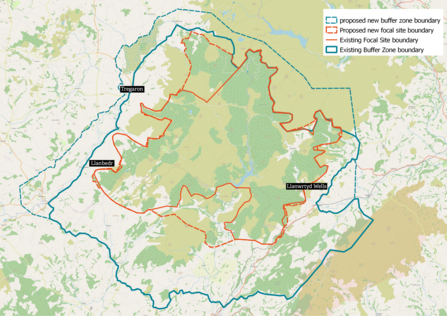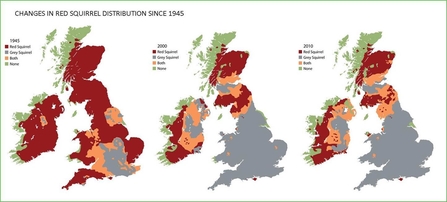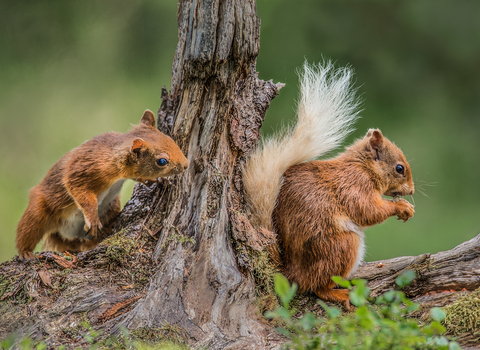Protecting our Mid-Wales Red Squirrel population
The Mid Wales Red Squirrel Partnership (MWRSP) was established in 2002 to protect the unique population of red squirrels in mid Wales; one of only three significant red squirrel populations in the whole of Wales, and the only one to survive without rereleases. Our work includes...
- establishing a buffer area around the stronghold with control of grey squirrels
- ongoing monitoring of the red squirrel population
- advising landowners on habitat improvements for red squirrels
- involving local schools and communities
- using forest planning to maximise the value of forests for red squirrels
The grey squirrel has been identified as one of the main threats to red squirrels' future survival; a threat which can only be mitigated with sustained local action.

Threat to red squirrels
Cynefin
Dinistrio a darnio cynefinoedd
Mae gostyngiad sylweddol yn y coed llydanddail, coetiroedd yn cael eu darnio fwyfwy a gorbori, yn arwain at lai o aildyfiant, ac mae hyn i gyd wedi cyfrannu at ddirywiad y gwiwerod coch yn y 19eg ganrif.
Fodd bynnag, nid yw hyn yn egluro’n llawn pam mae niferoedd y gwiwer coch yn y DG wedi gostwng. Yn eironig, mae’r coed conifferaidd a blannwyd yn gymharol ddiweddar yn darparu rhywfaint o fwyd newydd addas i’r gwiwerod coch a gall y coed hyn hefyd gynorthwyo â’u cadwraeth yn y dyfodol.
Cystadleuaeth
Mae gwiwerod coch o dan bwysau cynyddol gan gwiwerod llwyd anfrodorol. Cafodd y wiwer lwyd ei chyflwyno i’r DG yn y 1870au. Ers cyflwyno ychydig iawn o anifeiliaid, mae niferoedd y wiwer lwyd wedi cynyddu i dros 3 miliwn.
Mae gwiwerod llwyd wedi disodli poblogaethau’r wiwer goch ledled llawer o’u hen gynefinoedd; gall y wiwer lwyd gytrefu 6 milltir o goetir y flwyddyn, a bydd y wiwer goch fel arfer yn diflannu odi yno wedyn o fewn 15 mlynedd.
Mae gwiwerod llwyd yn fwy o maint felly yn bwyta mwy, ac hefyd mae nhw'n cynhyrchu mwy o wiwerod bach na’r wiwer goch. Yn ogystal, mae un hectar yn cynnal mwy o lwydion, sy’n eu gwneud yn fwy tebygol o oroesi. Er taw’r wiwer lwyd sydd â’r fantais dros y wiwer goch mewn coetiroedd llydanddail, nid felly yw’r sefyllfa mewn coedwigoedd conifferaidd.

Janet Wickens, 2014. Red Squirrel Survival Trust
Clefydau
Mae gwiwerod coch dan fygythiad o’r firws marwol, brech y gwiwerod (parapox), sy’n gallu dinistrio poblogaethau cyfan. Gall gwiwerod llwyd gario’r firws heb ddioddef niwed, ond nid oes unrhyw imiwnedd gan wiwerod coch. Ar ôl cael eu heintio, bydd gwiwerod coch yn marw o fewn ychydig wythnosau, neu hyd yn oed ddyddiau; nid oes unrhyw driniaeth hysbys ar gael. Gall y gwiwerod sy’n dioddef fod yn swrth a chrynedig, a bydd ganddynt grach neu friwiau o amgylch eu llygaid a’u trwynau.
Legal Protection
The Red squirrel is included in Schedules 5 and 6 of the Wildlife & Countryside Act 1981 (WCA) which means that it is a protected species. This legislation has subsequently been amended, most recently by the Countryside & Rights of Way Act 2000 (CRoW) for England and Wales.
The inclusion of the species in Schedule 5 means that, under Section 9 of the WCA it is an offence to:
-
Intentionally kill, injure or take (capture) a Red squirrel.
-
Intentionally or recklessly damage or destroy any structure or place a Red squirrel uses for shelter or protection or disturb a Red squirrel while it is occupying such a place.
-
Possess a dead or live wild Red squirrel, or any part of a Red squirrel, unless you can show that the animal was taken legally.
-
Sell, or offer for sale, a wild Red squirrel or any part of a wild Red squirrel.
Under Section 11 of the Act, it is also illegal to:
-
Set in place a trap, snare, electrical device for killing or stunning or any poisonous, poisoned or stupefying substance; use a decoy, gas or smoke, bows or cross-bows, explosives, automatic weapons or mechanically propelled vehicles which are of such a nature and so placed as to be calculated to cause bodily injury to a Red squirrel.
Grey squirrel control is a legal activity which does not need to be licensed. The Wildlife and Countryside Act 1981 (as amended) Schedule 9 makes it illegal to release, or to allow to escape, to the wild any captive Grey squirrel; the Wild Mammals (Protection) Act 1996 makes it illegal to subject Grey squirrels to wilful acts of cruelty or abuse; and the Destructive Imported Animals Act 1932 – makes it an offence to keep a Grey squirrel in captivity, except under licence. The legislation dictates...
- It is illegal to release a trapped Grey squirrel into the wild and it is also illegal to keep a Grey squirrel in captivity.
- Any Grey squirrel caught must be humanely destroyed.
- Drowning is an inhumane method of despatch.
- When trapping for Grey squirrels, traps must be visited once every 24 hours, but, where there is a risk of catching Red squirrels or other non-target species it is a legal requirement that traps are checked twice daily.
The Mid Wales Red Squirrel Project was awarded funding through the National Lottery Heritage Fund from 2019 to 2022 to continue its vital conservation work and important research.

